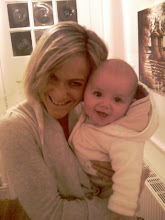 Here's a quick easy test you can do yourself to see if you still have separation of the abdominal wall or diastasis.
Here's a quick easy test you can do yourself to see if you still have separation of the abdominal wall or diastasis. 1. Lie on your back with knees bent and feet flat to floor. Make sure your lower back just brushes the floor underneath you - avoid pressing it too flat into the floor or over-arching it.
2. Take your index finger and third finger together and vertically place them just under the bra strap (breast bone). Then turn them horizontally and pass them, quite firmly, down the cenre of your front (known as the linea alba). It is the line from the breast bone down to the belly button.
3. Breathe in first, then breath out, slightly pull in your abdominal muscles and lift your shoulders and head off the floor. Press your two fingers down your vertical line, keeping gentle pressure. Take the fingers down to the belly button quite quickly.
4. Notice if the gap between the stomach muscles is greater than your two fingers. If so, there is still some separation, which indicates some instability.
If the gap is greater - we would concentrate on pelvic floor exercises/tilts and lower abdominal strengthening. You would avoid any kind of stomach crunches until the gap is smaller than the width of the two fingers.
With care and correct exercises, the gap will reduce and you can perform more advanced stomach exercises.
I run quick tests for Abdominal Separation, just as above, on our Spring Fitness Courses. Book your place and get your free test.
.jpg)

